The Celestial Streetcar
Melinda Barlow/University of Colorado at Boulder
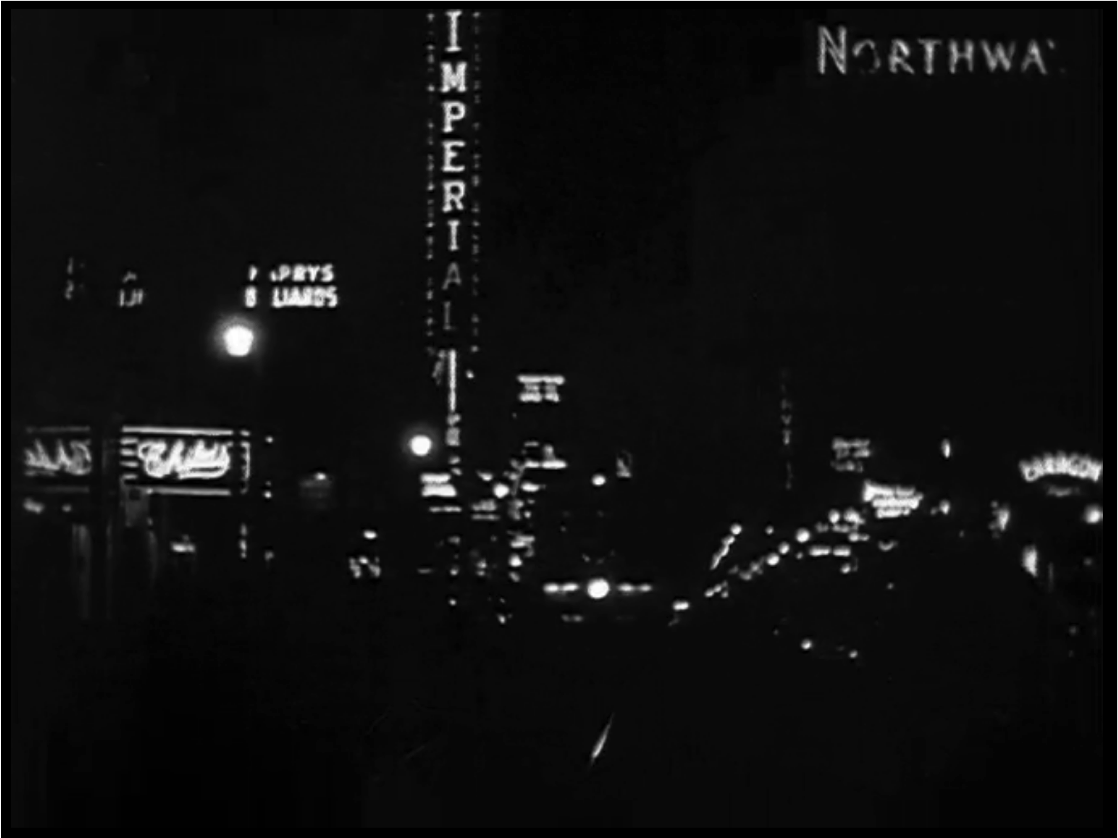
A moonless night, pricked with stars. I am at the old train station in downtown Boulder, the one built in 1890, sitting in a streetcar from the next century, a sleek red rocket with the familiar sea foam ceiling and maroon and cream exterior. A pair of binoculars hangs around my neck. There are no other passengers, and no driver.
With a lurch, the vehicle lifts off, moving forward while somehow traveling backward in time, linked to a vast web of cables and tracks that stretches impossibly from earth to sky. Making a left near the Flatirons, the car rises and falls like a roller coaster across the eastern plains that yield imperceptibly to western Kansas, buoyed by the winds that whirl above Lawrence, rattled by the rush of the Missouri River, veering north toward Springfield, Decatur and the corn and soy bean fields of central Illinois. I am elated: through the binoculars I glimpse my grandmother’s farm outside Jacksonville, the house with its wrap-around porch and green-roofed corn crib looking just as they did in snapshots from the 1960s.
Sailing on past the suburbs of Chicago—Downers Grove, Naperville, Oak Brook—the streetcar descends perilously close to the lake, blue-black and brackish, as if homing for water. I love hovering over the waves, riding an unexpected gust due east through the hills and valleys of the Lower Peninsula, and, more than anything, swerving around the Giant Tire by the highway just south of Detroit, the one that used to be a Ferris Wheel at the 1964 New York World’s Fair. Pure exhilaration. My parents must have passed it when they emigrated in 1965; we drove by it every year on long family road trips to Texas.
My internal compass knows what comes next: everything turns green, and there is more and more water. As Lake Erie leads to Lake Ontario, and the parks and bogs near London cede to the ravines and canopy of Tkaranto, the place “where there are trees are standing in the water,” the car leaps and dips, glides and soars, shakes, screeches, brakes and switches, sparking as it touches down and careens into the CNE. The midway is awhirl with light. Nearby, the lake lies quaking in the dark.
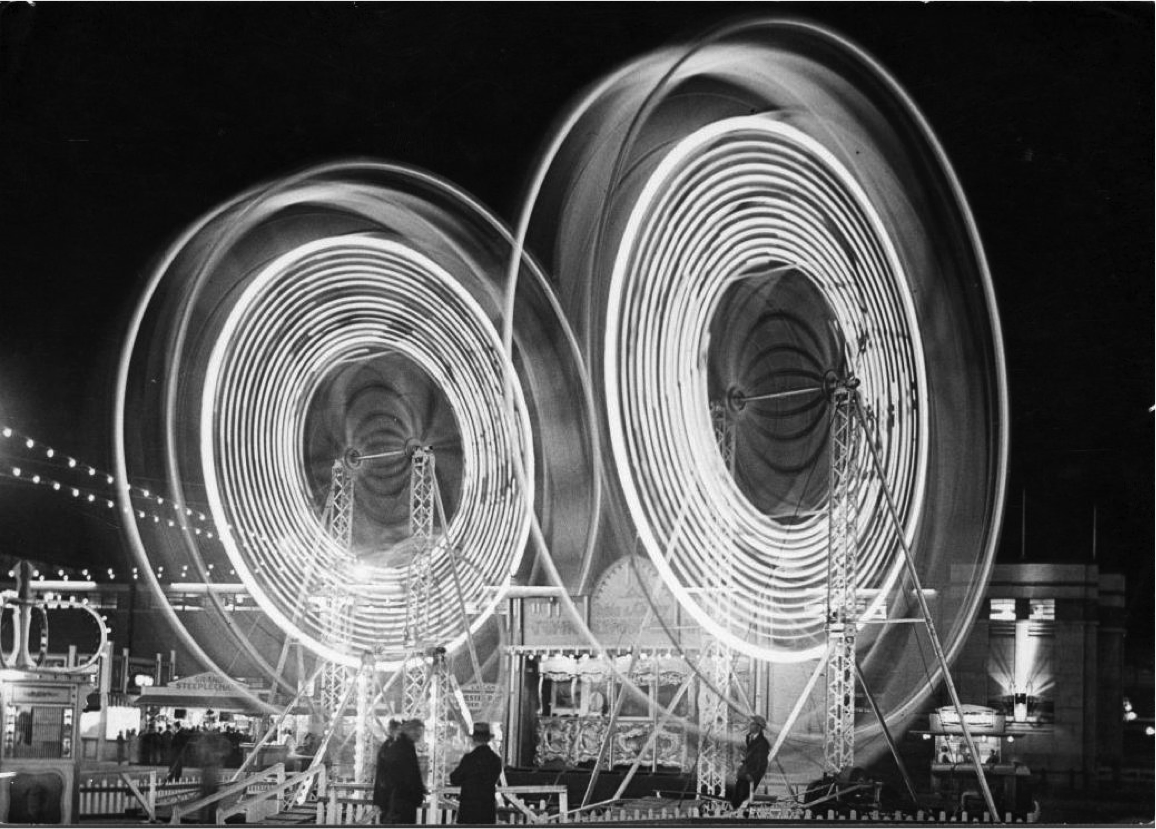
I have landed in Toronto twenty-five years before the boom. In the glinting tracks ahead and “neon glamour” at my back, I feel the allure of that not-too-distant future.1
I wake with a start, suddenly derailed.
I’m not there.

Toronto Boom Town (Leslie McFarlane, 1951), a National Film Board of Canada short narrated by radio broadcaster Elwood Glover and produced by Sydney Newman (twelve years before he created Dr. Who),2 charts the rise of the “Queen City” renowned for its Sunday Blue Laws and as the birthplace of Standard Time, now an urban center “growing like mad, bursting at the seams,” its dreams of “expanding industrial might” putting it at risk of being “strangled by its own prosperity.”3 Struggling with traffic and congestion due to post-war suburban expansion, the film documents the building of Canada’s first subway, which opened in 1954, promotes the city’s glamorous nightlife in a montage of hotspots and watering holes known for their spectacular neon signage (The El Mocambo and The Horseshoe Tavern among them), and reminds us, through a remark made by a visitor to mansion-turned-museum Casa Loma, that Toronto is a city of one million people (still) “living in a forest.”
But the film’s most telling riff, a textbook illustration of NFB founder John Grierson’s vision of documentary as the “creative treatment of actuality,” is its depiction of Canadian-American relations through the fictional meeting of Albert McConachie, from equally fictional Pine Tree Rapids, and Chester Vanderwick, a businessman from Ohio. In a conversation replete with the requisite long o’s and broad a’s defining each country’s accents, Mr. McConachie insists that Toronto is too big for him, and that he “wouldn’t live here if they gave [him] the place!” Mr. Vanderwick, however, bestows America’s highest compliment, describing TO as “smart and up to date, just like a good American city. Makes me feel like I’m back in Cleveland!” Framed by “Mr. Nice Guy” Glover’s perfectly pitched boosterist voice over, which lends humor and enthusiasm to the entire exchange, “Toronto the Good” in 1951 is primed to become the “City of the Future” emblematized 14 years later by the modernist City Hall designed by Finnish architect Viljo Revell, with its curved twin towers of differing heights enclosing a space-ship like council chamber.4

Toronto Boom Town’s idealized future takes an apocalyptic turn in Last Night (Don McKellar, 1998), a film showing the city on the verge of obliteration, littered and looted, its streets strewn with peculiar totems made from animal masks impaled on parking meters. Sandra (Sandra Oh) walks through this urban wasteland in search of a ride, sounding like a latter-day Dorothy Gale when she tells everyone she meets, including widower Patrick Wheeler (McKellar), “I have to get home.”
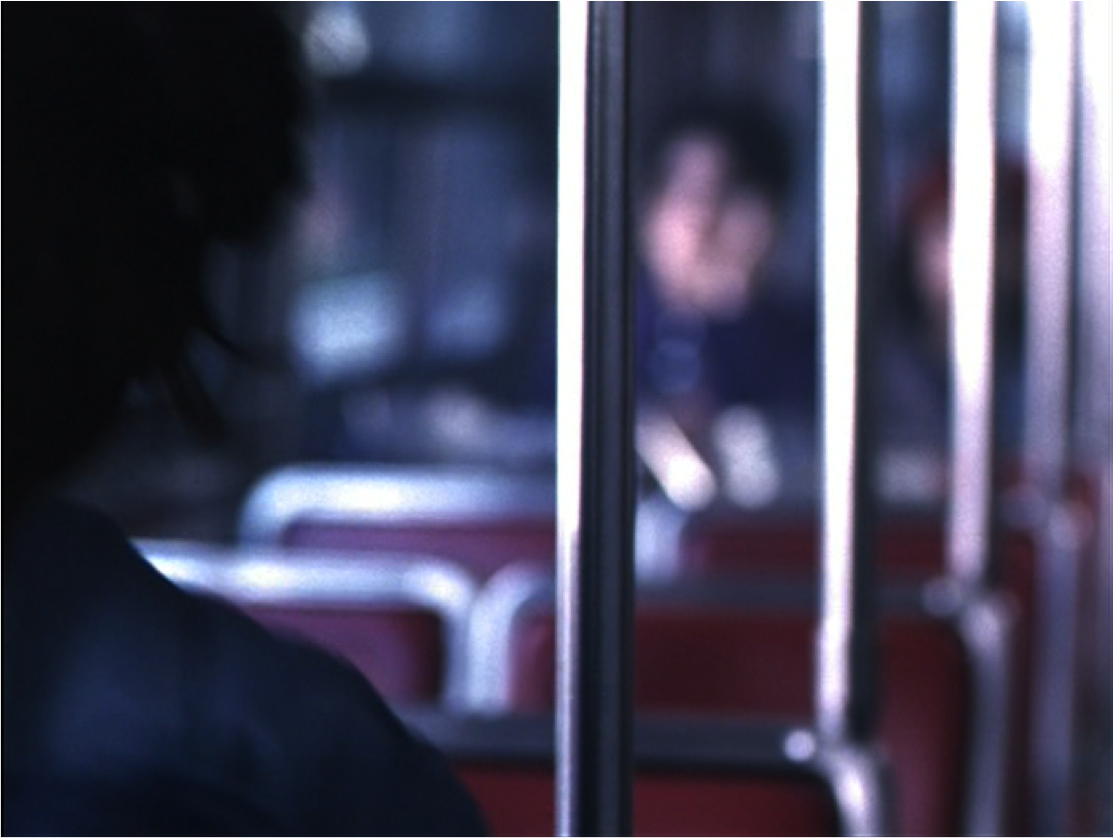
She wants to get there, however, to fulfill a mutual suicide pact with her husband Duncan (David Cronenberg), before the film’s unexplained catastrophe occurs at midnight. In one attempt to do so, she boards a driverless streetcar (a Canadian Light Rail Vehicle from the late 1970s, not the Art Deco Pullman car that haunts my dreams), whose two passengers, a despairing mother and her impatient daughter, seem to be waiting for something to happen. Rioting crowds eventually overturn the abandoned vehicle, and Sandra spends the final moments of the night exchanging personal intimacies with Patrick, whose way of describing his wife’s death rings with significance beyond the confines of the narrative: “After she died, they said the world would end.” The loss of a loved one, or even a beloved place, often feels like that. For a while, there is nothing left; the familiar terms of the universe are no more.
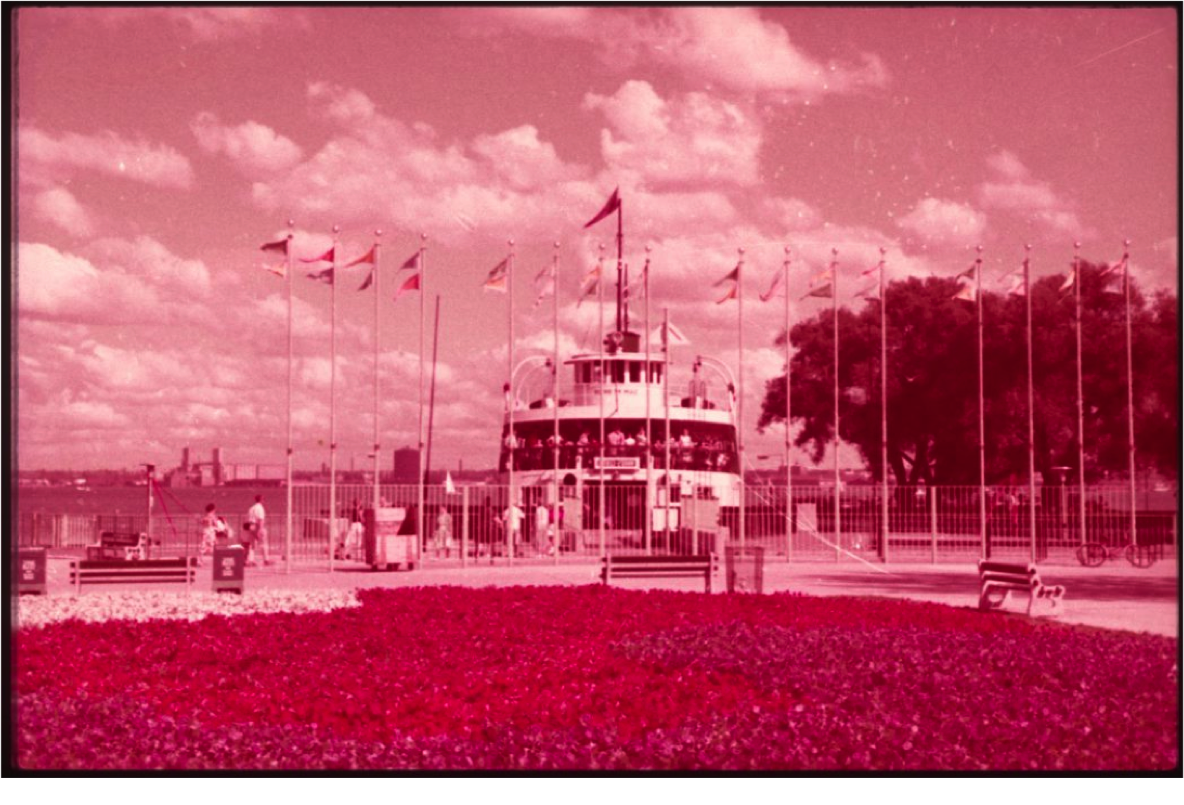
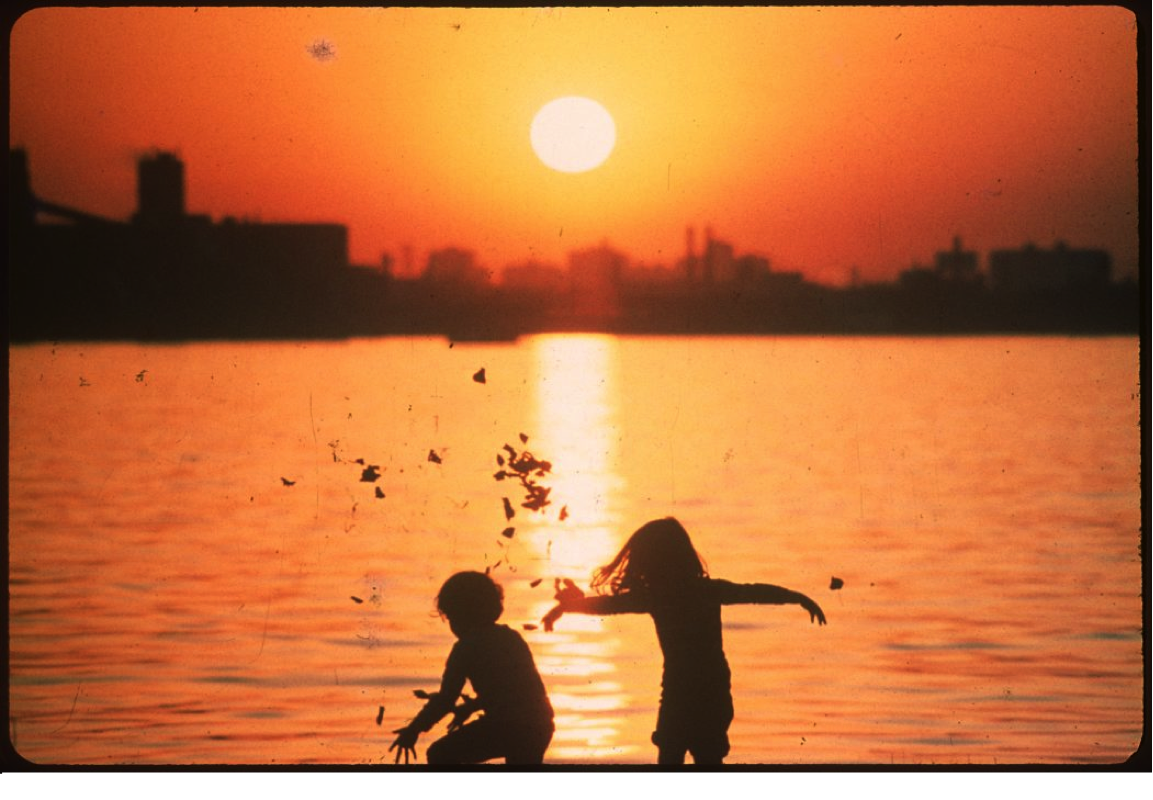
If I could, I would give Sandra another future, or at least add to the present that is (was) her last night, by giving her a ride—another ride, or perhaps a few—one down Bay Street to the waterfront on a working CLRV. Getting off at Queens Quay, she would board a time-traveling ferry to Centre Island (a “Technicolor” ride, thanks to the strength of magenta dyes), arriving during the Canadian Centennial (1967), a few years before her birth. There, bathed in the glow of a late summer sunset, after walking by the shore while children play nearby, she might stroll to the Centreville amusement park, and take a spin on The Scrambler, like Margot (Michelle Williams) does in Take this Waltz (Sarah Polley, 2011), years down the line. Whirling in the dark, her blues diffused by the lurid blend of lights, filled with a sense of abandon, thrilled at being in motion, and uniquely attuned to the passing of time, Sandra might find solace, I like to imagine, in being shaken up and turned around, before returning to a final evening of human communion which culminates, in the film’s last shot, in an unanticipated kiss.

In Take This Waltz, Margot also seeks temporary solace in a thrill ride, when she boards The Scrambler with a possible paramour as a way of shaking up her own life. Five years into a marriage that on the surface seems just fine, Margot is restless at the core, in search of something else. A woman who freely admits that she dislikes dislocation (the “rushing, not knowing,” of air travel, of being “in between things”), she nonetheless courts a new experience by responding to Daniel’s (Luke Kirby) attentions, thus placing herself in an emotionally liminal zone. “Life has a gap in it, in the big picture,” her former sister-in-law tells her much later in the film, after Margot has left her husband. Getting on The Scrambler, part of a long day with a man to whom she is irresistibly drawn, is one way of trying to fill in that gap. The ride is a diversion but also a place of transformation: first elated, then deflated, Margot’s expressions bring to light an internal struggle—her dark night of the soul.
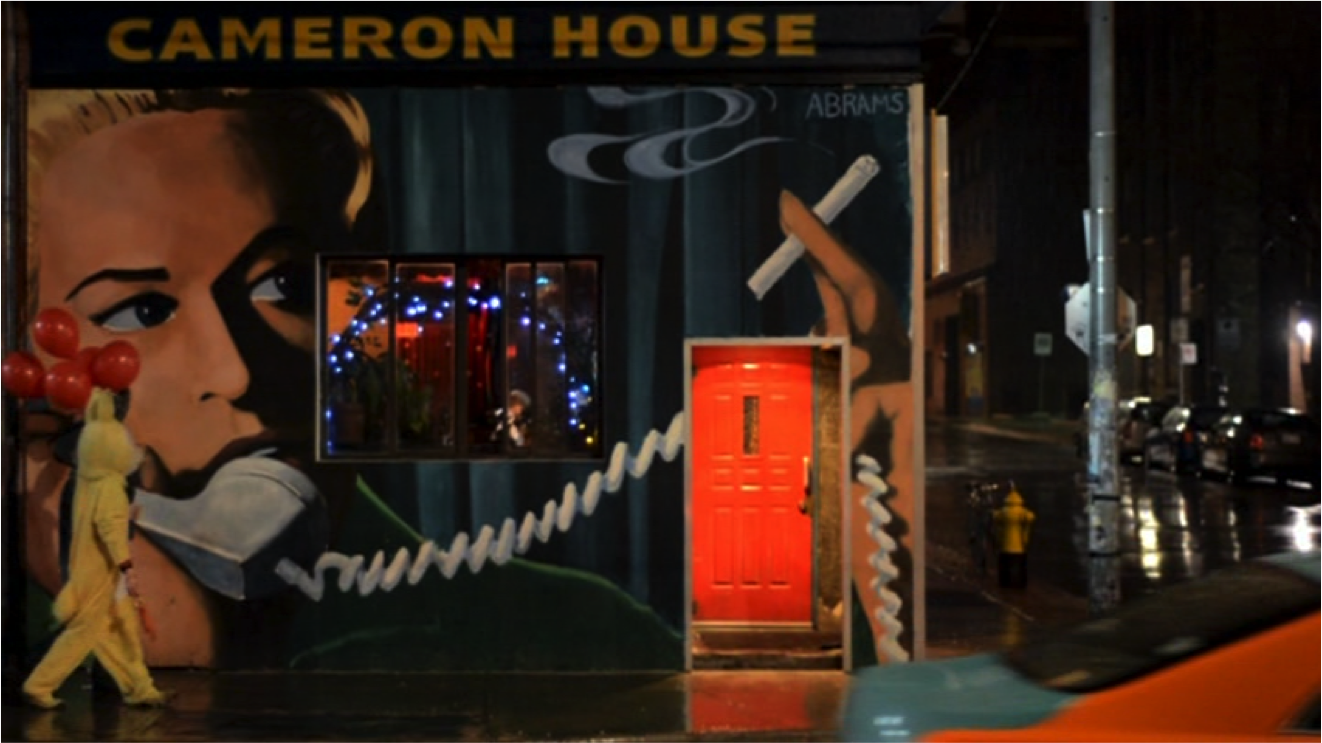
All of the characters in The Animal Project (Ingrid Veninger, 2013) experience dark (days and) nights of the soul when their acting teacher gives them an exercise that unexpectedly derails them. After watching a short film he made with his son Sam (Jacob Switzer) some ten years earlier, Leo (Aaron Poole) decides to adapt its method for a group of young performers, including himself. In the original film, called The Bunny Project, Sam, in full rabbit costume, offers hugs to passersby, and muses on life, death, and the nature of dreams.5 “Do you dream?,” he is asked by an off-screen voice, presumably his father’s. “I’ve had a dream that seems really real,” Sam answers—an experience, we soon learn, his father knows very well. Leo poses the same question, with slight variations, to his fellow actors, asking of one, “Have you ever died in your dreams?,” and of another, “What is the last thing you remember dreaming?” To the latter, he gets an answer that might be part of what unhinges him: Saul, with whom he has recently shared an unexpected moment of intimacy, answers, “It was about you.”
How and why this happens, and how the entire “chorus of misfits,” as Leo eventually describes himself and his six students, breaks apart, comes together, forges new bonds and deepens their connections, precisely because of the exercise he devises for them, creates a film which is an intricate study of projection, anonymity, authenticity, and identity, and the human capacity for intimacy, against all odds. The exercise? Don a full animal costume, mask and all, and go out into the world, interact, and see what happens—with others, and in you. Self-obliteration, Leo insists, is a “different kind of risk taking.” “Those animal heads wipe out the actor’s expression completely,” one student protests. “You could put anyone in those heads and it wouldn’t make a difference at all.” To some extent this is true. But what happens to each actor internally is distinct, and for each, adopting a guise ultimately yields something genuine. The exercise proves to be an unforeseen vehicle of transformation.
Toronto is the place where these transformations occur, in locations ranging from the elevated to the mundane, each beautifully shot by cinematographer Cabot McNenly: its glistening streets and glowing alleys, its parks and ravines, its laundromats, living rooms, diners (Vesta Lunch: “Reputable since 1955!”), churches, theaters, bars, clubs and, of course, down by the lake.
In one especially memorable sequence, Pippa (Jessica Greco) and Alice (Hannah Cheesman), The Donkey and The Rabbit, respectively, walk by the Cameron House, a 1920s hotel turned music venue in the 1980s, their bouquet of red balloons thrown into relief by the vibrant red of the club’s door, which is echoed by the orange glow of a passing cab, its turquoise trunk a perfect complement to the teal background of the striking mural on the club’s wall, which frames a window filled with an inviting arc of blue lights. As if beckoned, they enter, and dance in costume, while a balloon or two drifts to the ceiling. Later, on the street, a man gropes at Pippa after she offers him a balloon, and then he laughs at her distress. She breaks down.
Given how significant balloons are for her (“they are magic to me”), their inclusion here reads as a telling evocation of The Red Balloon (1956), Albert Morrisette’s fantasy film about a young boy in Ménilmontant who finds a sentient red balloon that follows him everywhere. Jealous children ultimately destroy his silent friend, but fantasy wins the day: all the balloons in Paris take Pascal on a cluster balloon ride over the rooftops of the city. As one critic put it in 1957, the film is “a poignant symbolization of dreams and the cruelty of those who puncture them.”6 The same might be said of The Animal Project. 7
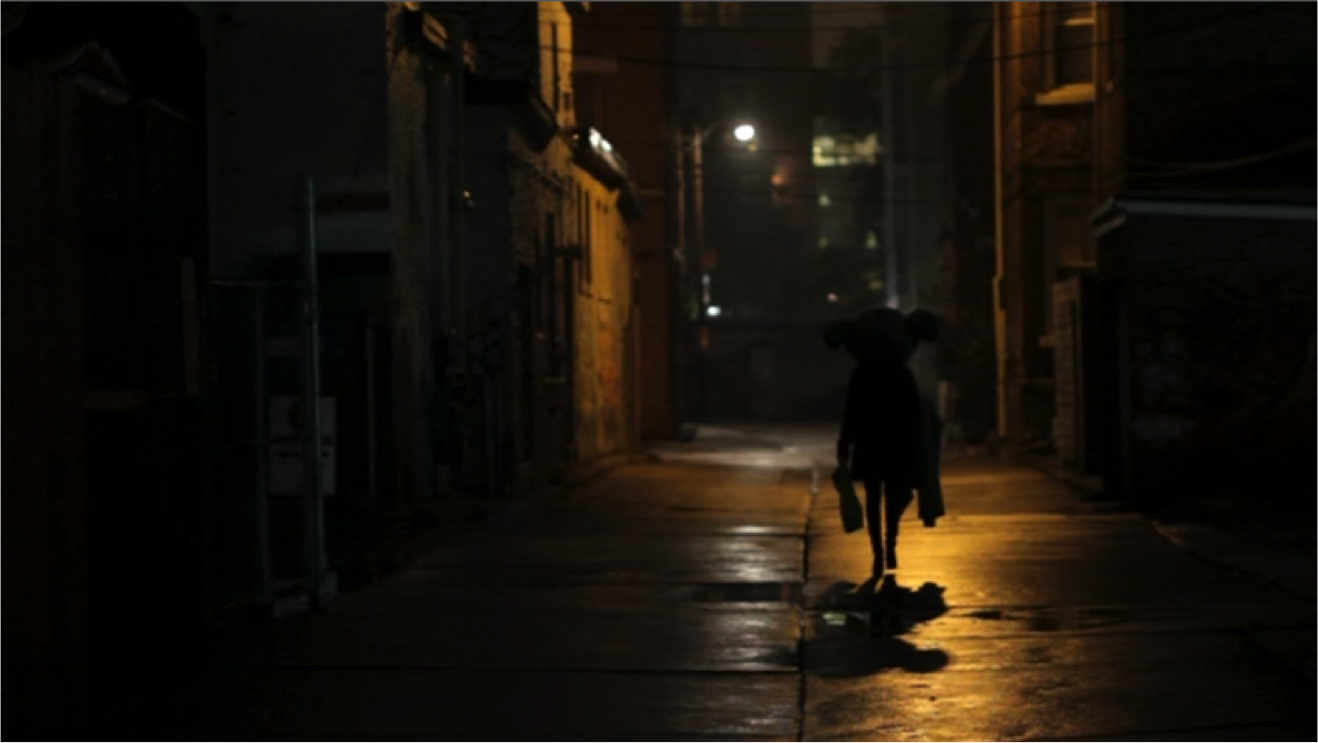
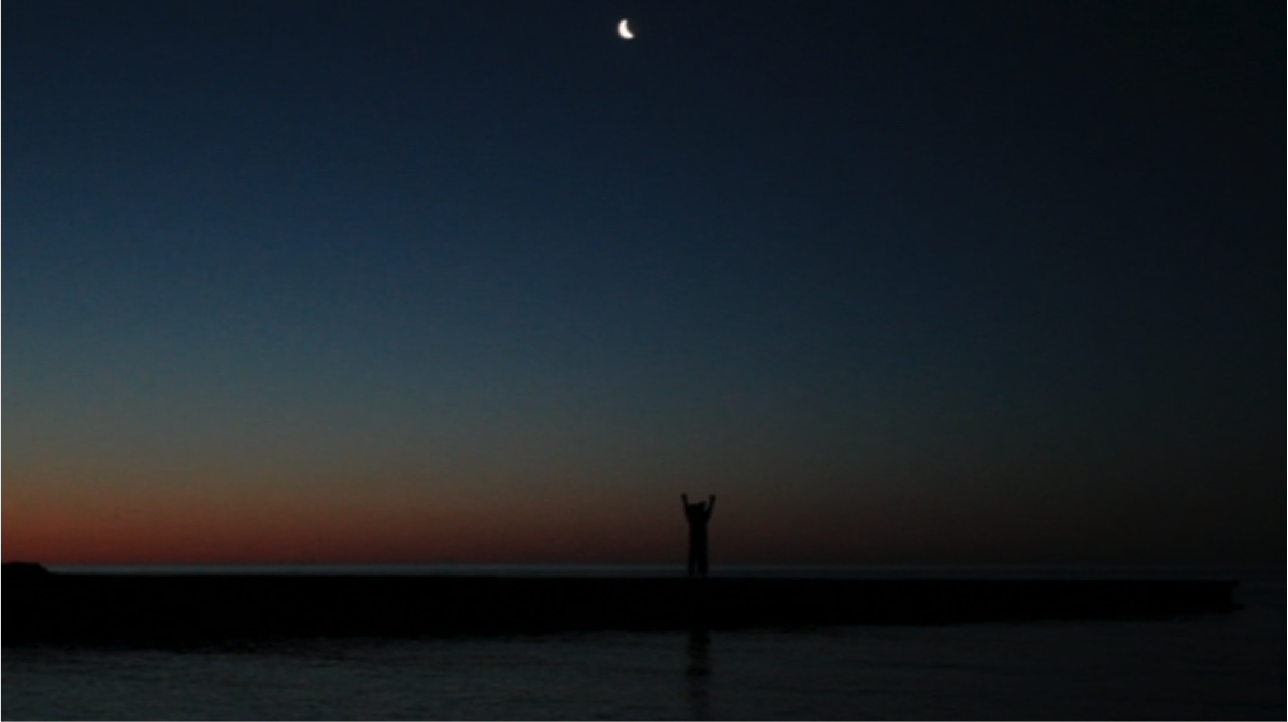
Other characters in the film wander the streets alone, exhibiting varying degrees of comfort with their costumes. While Mira The Mouse (Sarena Parmar), wearing only her mask, walks through a dark alley, its slick sidewalk glinting with gold, Jason The Cat (Johnathan Sousa), in full attire, meanders down to the lake at sunrise, raises his arms to the waxing moon (a stretch of despair or an appeal for strength?), then sits on the dock, waves lapping at his back, pondering a momentous decision. When the light shifts, he leaps up, runs all the way to The Mouse’s house, takes off his mask, and declares that he is going to kiss her. He does.
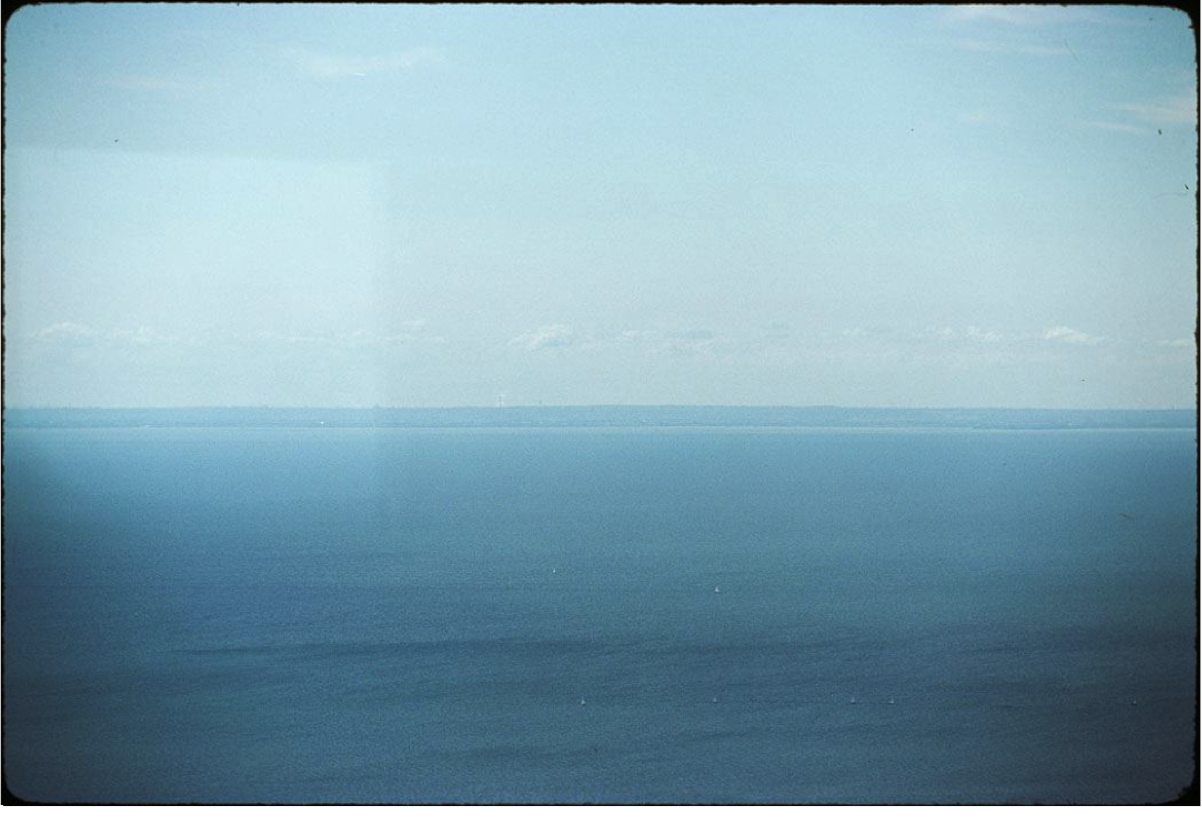
Lingering by the “Lake of Shining Waters” facilitates his transformation. Gazing out at that infinite expanse of blue, as balanced and restorative as a minimalist painting,8 Jason faces his own emptiness, and feels “the blue of longing.” Blue, writes Rebecca Solnit, is “the color of an emotion, the color of solitude and desire, the color of there seen from here, the color of where you are not.”9 To get there, Jason jogs the distance, taking the lake’s quiet enlightenment with him.
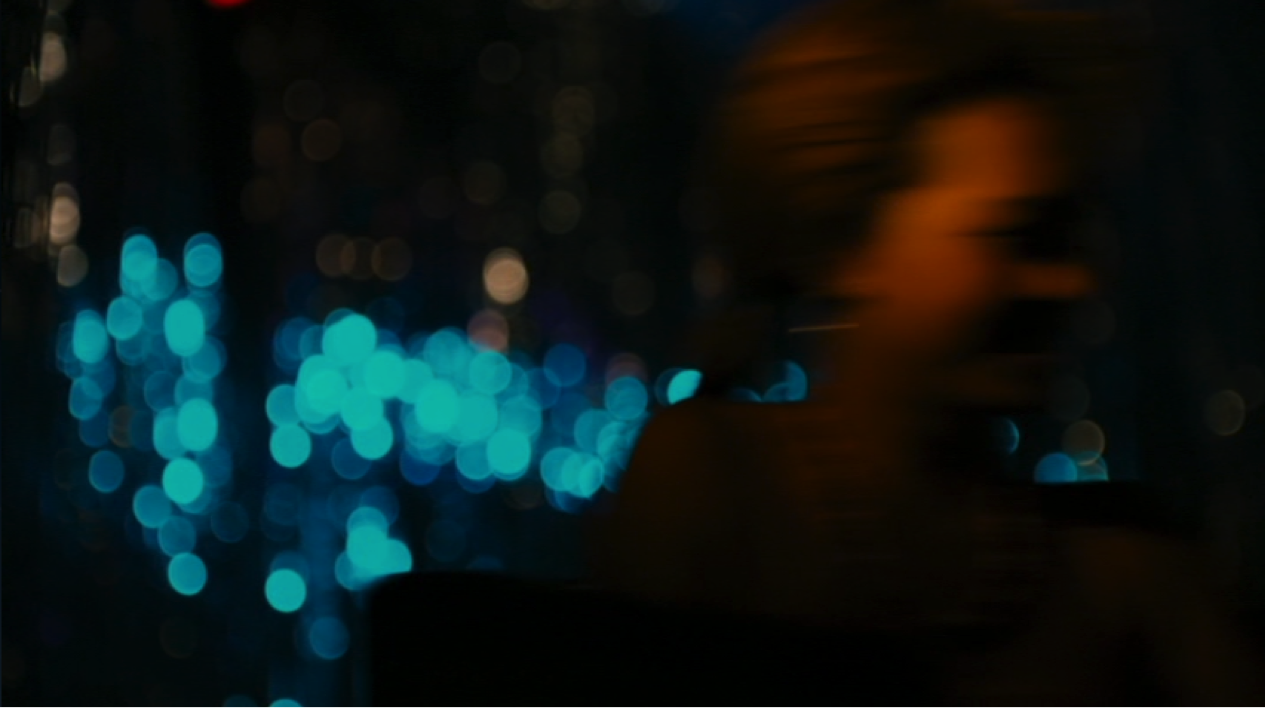
Whenever you leave, wherever you go, you take that blue glow with you, its radiance at your back. On the next ride, on the road, out of town, on the tracks, in a streetcar, in the air, looking back, glancing ahead—longing, Solnit reminds us, is a sensation to be cherished on its own terms. Something is always far away, and something always needs letting go.
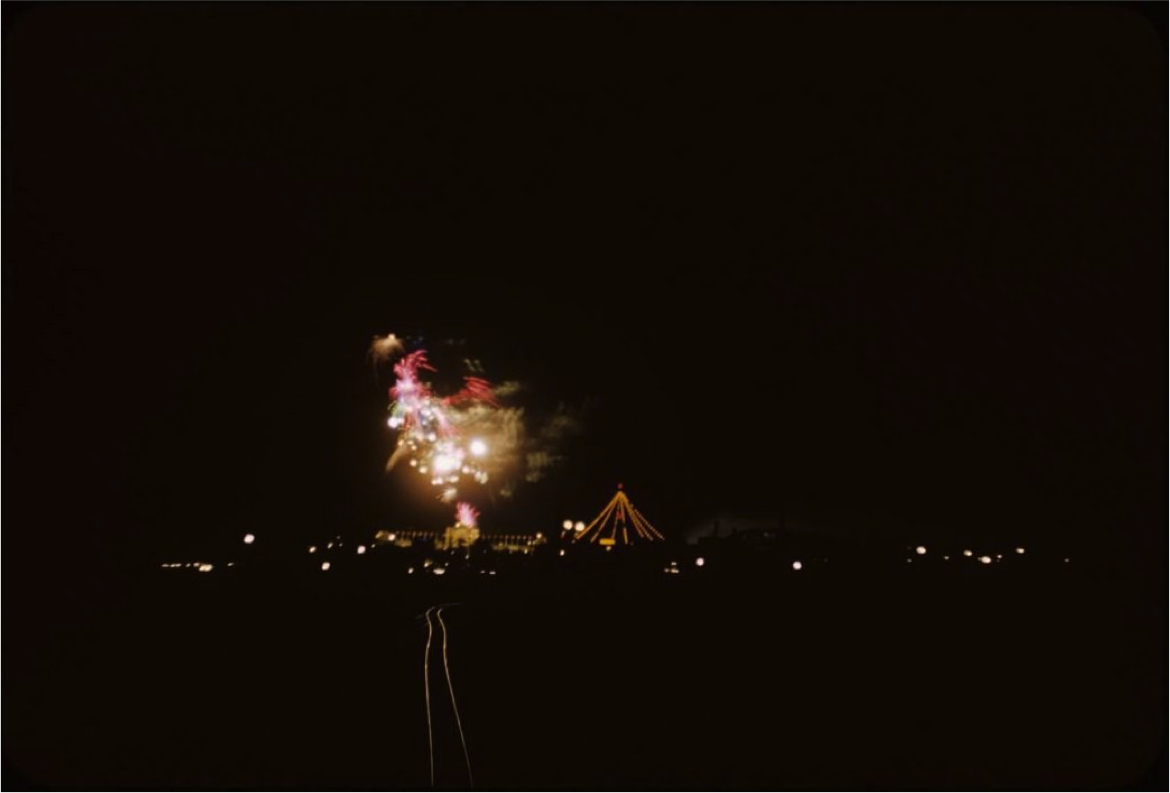
A moon, a red balloon, a faint blue gleam in a vast black sky. A wish drifting heavenward. A streetcar creaking homeward. This is my dream.
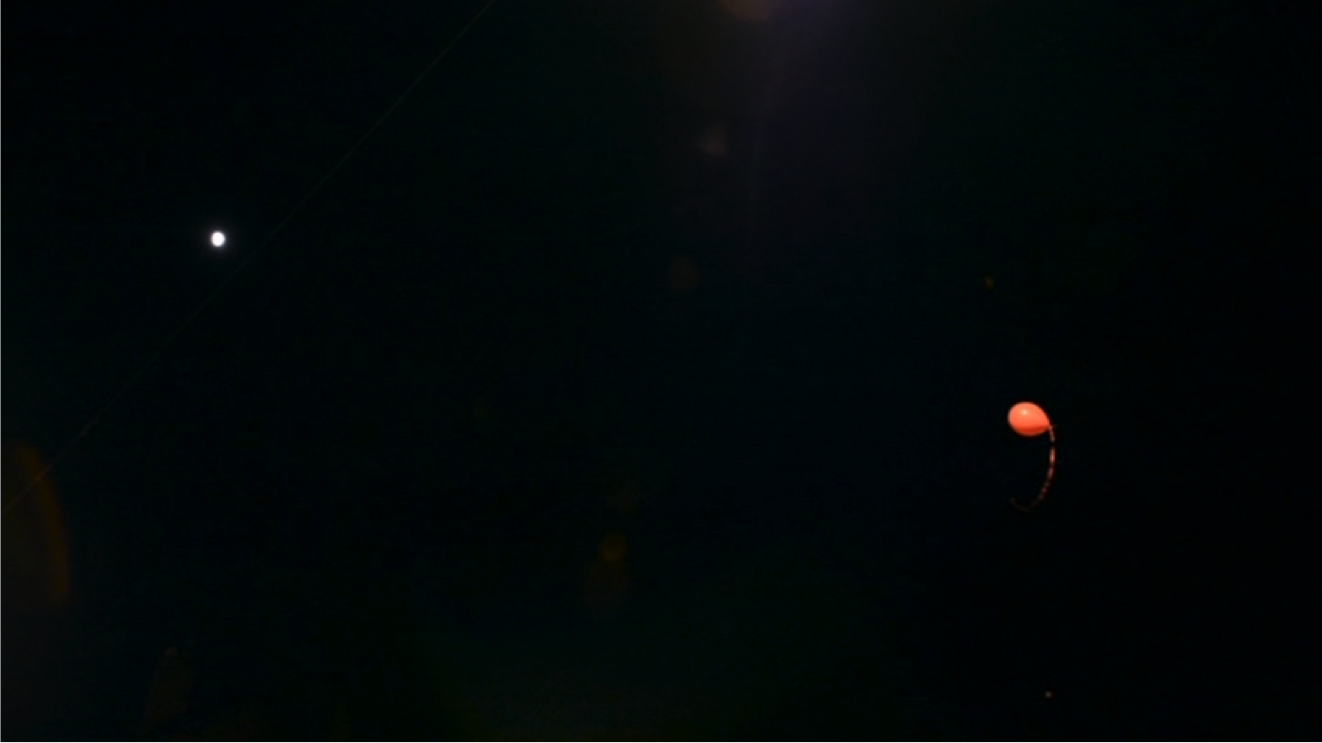
For my mother, who helped the Toronto Transit Commission make the streetcars accessible for everyone. 10 And for Ingrid, whose films brought me home.
Image Credits:
1. Toronto Boom Town (Leslie McFarlane, 1951).
2. The Canadian National Exhibition, 1922. City of Toronto Archives.
3. Official opening of Toronto City Hall, 1965. City of Toronto Archives.
4. Last Night (Don McKellar, 1998).
5. Last Night (Don McKellar, 1998).
6. The City of Toronto Archives.
7. The City of Toronto Archives.
8. The Scrambler at Centre Island in Take This Waltz (Sarah Polley, 2011).
9. The Animal Project (Ingrid Veninger, 2013).
10. The Animal Project (Ingrid Veninger, 2013).
11. The Animal Project (Ingrid Veninger, 2013).
12. Lake Ontario: “The Lake of Shining Waters” in the Wyandot (Huron) language. The City of Toronto Archives.
13. Take This Waltz (Sarah Polley, 2011).
14. The Canadian National Exhibition, 1954. The City of Toronto Archives.
15. The Animal Project (Ingrid Veninger, 2013).
Please feel free to comment.
- The phrase “neon glamour” is used in Toronto Boom Town (Leslie McFarlane 1951) to describe Toronto after dark. [↩]
- For more context on the Torontonian roots of this iconic British television series, see Adam Bunch, The Toronto Dreams Project Historical Ephemera Blog, November 11, 2013. The Toronto Dreams Project, created by Bunch, is a fascinating intervention into Canadian history. Taking a cue from Banksy, Bunch creates fictional dreams, inspired by the lives of famous figures in Toronto history, writes them on the back of post cards featuring related collages on the front, and leaves them at various sites related to those figures all over the city. [↩]
- Given the current real estate boom in Toronto, it is not surprising that recent reviewers of this NFB short drew the parallel between the Toronto of 1951, and the Toronto of 2014. Another article attesting to the city’s new boom appeared this year in the Huffington Post. And Don McKellar’s recent TV series starring Kim Cattrall for HBO Canada, Sensitive Skin, which premiered on July 20, 2014, features many references to Toronto’s new “cyber lofts,” and in its vision of the city, everyone is always waiting for a streetcar that never seems to arrive! [↩]
- The futuristic look of Toronto City Hall in Nathan Phillips Square has long made it associated with different kinds of science fiction. See The Toronto Dreams Project Historical Ephemera Blog. [↩]
- Ingrid Veninger appears in The Bunny Project twirling a baton in the background behind her son, actor Jacob Switzer, in this film within a film, thus lending The Animal Project not only an interesting degree of reflexivity, but an autobiographical dimension as well. [↩]
- Bosley Crowther, The New York Times, March 12, 1957. [↩]
- Another interesting point of comparison with The Red Balloon: Albert Morrisette’s son Pascal played the central character in his father’s film, just as Ingrid Veninger’s son Jacob Switzer plays the character of Sam in The Animal Project. Veninger’s daughter Hallie Switzer stars in Veninger’s films Modra (2010) and i am a good person/i am a bad person (2011). Veninger has also acted in many of the films she has directed, including: Only (2008) and i am a good person/i am a bad person. [↩]
- I am thinking here of works by Mark Rothko and Agnes Martin. See Rothko’s paintings Untitled (Blue Divided by Blue) (1966), and Untitled (Green on Blue) (1968). See Martin’s painting Falling Blue (1963). [↩]
- Rebecca Solnit, A Field Guide to Getting Lost (New York: Penguin Books, 2005) 29. [↩]
- On August 31st, 2014, on the Spadina line, Toronto rolled out the first low-to-the-ground, accessible Flexity Outlook streetcars. [↩]
Melinda,
What I really appreciate looking at this piece as part of your 3-column cycle is how skilled you are at creating a sense of place, mood, and tone, and the way you use this skill to highlight the work of female artists. From Texas, to Kansas, and now Toronto, the dreamscapes you describe are both familiar (based in actual reality or cultural reference points) and alien. My trip to Toronto in February gave me a glimpse into the mysterious, isolated beauty of that city in the depths of winter. In fact, most of my experience of the city was seen through the windows of a streetcar (or cab) as I desperately tried to avoid the bone-chilling cold that was unlike anything I’d ever experienced. I can see how protagonists like Sandra and Margot experience a sense of displacement, as I felt that myself. Particularly given that Toronto often subs for New York in movies, Toronto was like an alternate reality for me: exceedingly familiar and yet not the same.
I was also astonished by the Canadian landscape paintings that I saw at the Art Gallery of Ontario, silent landscapes of snow and a variety of shades of blue. It’s clear why this particular city gives rise to filmmakers and artists. I felt lonely during my time there, and yet oddly comforted at the same time-like warmth was right around the next corner constantly giving me something to seek out and discover.
I also appreciate how you’ve given attention to directors like Sarah Polley, who don’t often get their due even within discussions of female filmmakers. I personally struggled with Take This Waltz, perhaps because of the exact sense of ennui and displacement you mention was unsettling. The film felt inaccessible to me, which I think is intentional, but occasionally it verged on feeling like a succession of indie tropes strung together to create something that was aesthetically affecting but emotionally cool. I wonder if there’s something more to be gleaned from the film by a Canadian audience rather than an American audience?
To conclude, I’ve enjoyed how the way you write makes your topics both universal and personal to you as a writer and to the reader. It’s easy to add my own associations to your pieces, whether that’s my cowboy grandfather in the first piece, my mother’s obsession with Wizard of Oz in the second, or my Toronto trip in the the third.As Don Draper puts it in the Mad Men episode “The Wheel” (which you screened in your 40s and 50s class), your work “takes us to a place we long to go again,” even if we’ve never been there before.
Thanks so much for your contributions to Flow!
Natalie
Melinda,
There’s a sincerity to this piece that is rather appealing to someone like myself, who’s only ventured across the northern border once or twice and only ever glimpsed into the curious Canadian metropolis that is Toronto. As a student abroad, who’s currently studying in England, I find that this piece in particular – with it’s international perspective – brings a different texture with the films you’ve discussed. The sweet, transporting narrative introduction really puts the geography in perspective and anachronistically links these nearby countries with a transportation system that has been partially enveloped with the passing of time.
Mr. Vanderwick’s comments in Boom Town about Toronto being ‘like a good American city’ exemplify the Americanized perspective on the American city. It does happen to be the only Canadian city which participates in the American League sports of basketball and baseball. But, the conversation between the two seems to bolster the idea that Toronto is the staple Canadian city. What little time I’ve spent in the country has always left me feeling inexplicably different in a rather familiar environment. Lorraine Mallinder, of the BBC, wrote a very brief piece about Canadian identity in 2012, riffing on the distinct qualities that make someone uniquely Canadian. Like any nationality, I think their identity is morphing with the passage of time and changing climates. But! I think Toronto seems to represent the largest sail in the Magellan-like conquest to discover identity.
The pieces regarding The Animal Project really stirred up a sense of whimsy in my mind. I felt that the colorful characters, the apt connection to The Red Balloon, and the unique settings within the film really paint a portrait of Toronto that is something out of a modern fantasy. It combines the vivid and tangible nearby nature with a more intimate view of the city. The connection with nature and the scene by the lake may be the most transporting aspect of this piece, as it then widens my scope on Toronto and places it, this bustling young city, in the context of tranquil and timeless natural surroundings.
I find the “Scrambler” sequence in Take This Waltz to be some ephemeral, euphoria for our main character. You mentioned a ‘temporary solace’ for our restless main character and I can associate with that feeling of needing to disappear from the familiar world for a while and just ride. I would like to concur with Natalie’s comment about drawing attention to the films of Sarah Polley. I do find that her films, perhaps in their subtle emotional gestures, have something uniquely Canadian about them.
What was telling in this piece was the connection Canadian filmmakers had with the city. It’s a city that vests a lot of power in it’s youth and has a sweet subtlety to it that makes it a special place to appreciate, especially for those who have invested any bit of time there. Again, a truly fascinating read!
Branson
(currently abroad at)
Lancaster University
Melinda,
I love the dream journey you take me on in the opening of this piece and the invitation to explore the dream-like, chromatically enticing Toronto depicted in the films you mention, none of which I’ve seen. Equally whimsical and elegiac, this is a fantastic endnote to your trilogy which provides a parallel vision of some of your geographic and filmic touchstones. Thank you for sharing these deeply intimate, scholastically marvelous portraits.
–Joan
Melinda,
Wonderful piece! THE ANIMAL PROJECT’s narrative works so well within this context. The first scene, an interior setting of personal matter-of-fact questioning between the actors “Do you find me attractive?” progressing to the final scene of masked animal costumes running in unison through nature. The arc of curiosity and identity forming within the city to a communal experience after venturing into the streets lends itself so well to the “young city” growing into its own and “the space between things.” Ingrid is such an articulate ambassador for the city, performance, and exploratory filmmaking.
Matthew Campbell
Programmer
Denver Film Society
Wow, again spectacular article! My first impression is of a deep-seated sense of homesickness, which given that I am reading/writing this in my childhood home befuddled me momentarily. But then, reflecting on that feeling it was more a homesickness for the idealized or imagined home of my youth. Having lived the majority of my life within a 15 mile radius of Boulder I have seen this area explode. Not to date myself too completely but I remember when Boulder was in fact a separate city from Louisville, Lafayette, Erie, Broomfield, etc. In the expansion of the urban sprawl that has changed the landscape of this area somehow that idealized world of my youth has been covered in subdivisions and asphalt. This realization lead me to think about the movies that represent the area (granted pretty much anything reminds me of the movies, and more often than not of Star Wars but that’s totally a personal quirk). There are the major representations of Boulder, Mork and Mindy, brief moments of The Shining, and then the more obscure films that show Colorado, like Phantoms that was shot almost entirely in Georgetown or Catch and Release that was shot primarily in Boulder. However none of these films seem to capture the essence of the Boulder area. While this I think is a major error on the part of filmmakers, total hometown bias here, it created a link to the experiences of watching movies (again not a huge surprise) but there is such a connection to the experience of watching a movie with an audience for the first time and the past to me. Whether that is the Boulder Outdoor Film Festival showing of Rocky Horror or my favorite seats at my favorite theater on opening night of whatever is being released that week there is always a sense of returning home to the warm comfort of the past that I remember.
On a less existential note the inclusion of the importance of the color blue reminded me of a film I recently discovered and fell in love with, Powell and Pressburger’s 1947 film Black Narcissus. Without a full plot summary the story revolves around a group of Nuns who open a school and hospital somewhere in India. While the film is ripe with colonial messages (unsurprising given that the film was a British production released the same year India gained independence), it is the Technicolor process on full display in all its glory that stands out within that film. More than that I would argue the color blue plays one of the most important roles within the film in the links the color creates to memory. I actually wish I had known that Solnit quote before I had written about the color blue for a paper. While not entirely pertinent, memory, home, and how we find our own home and hopes within film are issues at play within the film, and are also some of the things that your article got me thinking about.
Again awesome job, and thanks for illuminating the rest of us (sorry a light/movie pun was just waiting to be made). Excellent article!
Robby Mehls
BAMA Candidate
University of Colorado, Boulder
Professor Barlow,
This is a lovely essay. I am astonished by the simultaneous personal depth and inviting openness of the piece. The opening dream description creates a very intimate space, one of dreams and unconscious exploration, that layers all the artistic analysis and references with clear personal weight and significance; yet there is also a reserved, suggestive tone to your writing that invites the reader to invest their own thoughts and experiences in your descriptions and analyses. Just as you describe this immense, timeless personal pull to Toronto, to a place that is formative and powerful, whether you are there or away (just as it does for the characters in the films you describe), made me ponder places like this in my own life, places I maybe had not thought about in this context. The unconscious pull of a location, or the subliminal power it exerts on us while we are there (and which subsequently follows us always), is a fascinating idea, but also a deeply ethereal one, which I would personally find immensely difficult to put into writing. This is the gift of this essay, I think – it finds a verbal way in to exploring these ideas, making them personal through sharing your dreams and visions, but also universal through both your writing style and analysis of multiple filmed examples of these ideas, demonstrating how these concepts seep into a multitude of works produced in Toronto. It is a good and eye-opening reminder of how the spaces in which one exists leave traces in one’s interior and exterior being, lingering in our dreams, and coming to bear on the art one creates.
The primary personal connection for me was also with a Canadian space, funnily enough; the lake in Ontario where my family goes fishing every year (and has done for over 40 years now) isn’t a space I’ve spent an enormous amount of time in, all things considered, yet I feel the power and sway you write about here in it. That lake and the surrounding greenery inhabits my dreams more often than most real-world spaces; and though I have not made a film myself, when I think of movie plots, or images I would like to photograph, I find myself thinking of that space, or of spaces like it. Certainly, there is that ‘blue’ connection Solnit writes about, the glow with the radiant pull that is “always far away,” but always pulling us back – I think everyone must have a space like this in their lives. Perhaps it doesn’t even have to be real, or may only be suggested by reality. As your essay suggests, the powerful ‘space’ we create and experience in our unconscious self is a combination of reality, our interior being, and the space between the two. It is inherently personal, in this way, which is why your highly personal essay works so well in conveying the sensation.
Thank you very much for sharing this.
Jonathan R. Lack
BAMA Candidate
University of Colorado at Boulder
Professor Barlow,
What an amazing piece, it really gave me beautiful overview of the city of Toronto but most of all of the general feeling that you glean from it and the way you bring it to life through such stark imagery (not only the photos, but the scenes of the movies you describe) is really great. My favorite aspect of it is how you connect the city’s environment with other cities in your past, and especially with the concept of leaving, and the feelings and memories that linger after you finally do. Afterwards, you connect it back into the aspect of returning to the place, and the feelings associated with that.
Your analogy of the color blue following you is spot on. Unfortunately, the only two examples I can think of set in Toronto are the new Daniel Radcliffe movie “What If” and the David Cronenberg film “Dead Ringers,” the former painting a loving, dreamy portrait of Toronto similar to that of Woody Allen’s of Manhattan, and the latter painting an eerie portrait through blurry windows and half-closed shutters. And, just as you describe it, both films have a mainly blue color to them. If I had to make a direct connection to that, I would say the color that follows me in relation to Mexico City is definitely gray. I’m not sure if it is because of the city’s ubiquitous concrete and cement, perhaps for the smoggy skies you learn to get used to and eventually joke about, or maybe it’s a kind of unconscious impulse that we come upon because of the nature of the city. But despite the drabness associated with that color, I see it as a happy gray, bespeckled with the vibrant colors often associated with my country. I would associate Mexico City with films such as Iñarritu’s “Amores Perros,” the popular socio-economic comedy “Nosotros los Nobles,” and especially the Cuarón masterpiece “Y tu mama tambien.” While “Nosotros los Nobles” provides “look it’s that place we recognize” moments, “Y tu mama tambien” weaves a great amount of the aspects of Mexican life into a think tapestry of a film. It really shows the joys and idiosyncrasies that people in Mexico live every day. I have hundreds of personal associations with Mexico City, but it would take an essay to describe them all.
The descriptions of your associations to different films is fantastic, and I look forward to watching some of your examples (especially “The Red Balloon,” that sounds delightful) to expand my understanding of your essay. I congratulate you on a fantastic piece of writing.
Juan Mateo Menendez
Undergraduate Film Studies BFA Candidate
University of Colorado Boulder
Originally from Mexico City
It would be impossible for me to travel through this dream sequence without it being personal. The dream, albeit different in detail, is my dream too. What I love about this Melinda, is your way of both traveling across the country while simultaneously traveling through time, back to the distant past of Toronto and to the Toronto of our youth. It is never far from mind and sometimes so close I too, awake with a start only to realize that I am not there either.
What draws me in to this narrative is the way our perception of the familiar can change over time. From the NFB film to the subsequent snapshots of the city in later films, things start to seem out of focus or somehow off balance. Maybe not as apocalyptic as the cityscape in Last Night but having been gone for half my life and to return to a place so familiar and yet so strange, I experience the same sensation. I know where I am but yet I don’t know it anymore.
I love the NFB film and its depiction of Toronto. My parents immigrated to Toronto (from small town Ontario) in 1953 and this is very much the Toronto of their young married life. They felt very fortunate to have been given the opportunity to make a life for themselves and their family in Toronto and constantly conveyed this sentiment to us growing up in subtle and not so subtle ways. We were always shown the advantages that the city had to offer; artistically, culturally, and in the unique small town neighbourhood atmosphere so characteristic of “my Toronto” then…a big city finding its way during and after the baby boom of the 1950’s and 1960’s. For so long, Toronto saw itself as a second class citizen, lacking the glamour of New York and without the culture of Montreal. And I think we all bought into that version. Now, I am amazed and proud of the city it has become and yet sad and pining for the city I once knew.
From Casa Loma (my birthday parties!), to the neon lights of the El Mocambo, the Cameron House; all take me on a journey back in time to a city that no longer exists except in my mind. And in my mind, I return to it often. A wish drifting heavenward. A streetcar creaking homeward. This too is my dream.
Thank you Melinda, for this ride.
The dream, the streetcar, the journey, the life that Toronto exudes is one that is difficult to articulate. It is a life that is felt and silently acknowledged within each citizen, each Torontonian at heart. Very few can capture the life that the city exudes, and this article is one of them. The various elements and films in this article create a beautiful, dream-like narrative of Toronto that personally resonates with me in many ways.
As a Colorado native currently living in Toronto, the streetcar’s journey is particularly striking. Once new and fascinated by the ride, the screeches, the shaking, the sparking, and the shuffling has now become a daily familiarity, a routine. Historically, the streetcars in Toronto are fascinating, but history can be forgotten in the forefront of our minds. It’s magic lost. However, it is in this article where the magic in riding a streetcar is returned and reinvented. I read this article last night, amazed at the prose that creates dreams within us all; and this morning, as I got onto the streetcar I briefly closed my eyes and imagined/felt the magic of traveling via the streetcar. It was not a moment of physically traveling from my flat to the subway, but a dream of journeying through life. Having recently taken the roadtrip from Colorado to TO (with all of my belongings in the trunk), this article awoke sensorial memories of traveling from my home to my future. From the seeing the last Colorado sunrise to that first moment of viewing the lake and city landscape, and everything in between, these sensory memories evoked a variety of emotions. But it also evoked a consciousness of transformation. This article also brilliantly illustrates the journey of transformation – transforming from the person you were to the person you are in this very moment. “Toronto is the place where these transformations occur” is a line that cannot be truer. That which occurs within us and around us, this transformation, this spirit is one that is inherently felt, but rarely articulated. Whether you live in the city, or are far from it, the spirit of TO follows you. This article is a perfect example of articulating this spirit and the transformations that continually occur in the city and more importantly, in its people.
Melinda’s newest article is one of my personal favorites, and one of the best (so far!). Thank you Melinda for another great article. There is so much to take away from it and I wish I could expand on it more. It will be one that sticks with me as I live here in the city (and take the streetcar) and when I am away from it. Sincerely, thank you.
Kelli M Johnson
MA Candidate – Cinema Studies
University of Toronto
Melinda,
Your trilogy meanders as a river does to an open sea. Your final piece, The Celestial Streetcar, feels as vibrant as a rushing river on the edge of meeting the warm salt water of the sea. Within this meditation, as you describe the flashing lights of Toronto boom town as if you are a celestial presence yourself, you remain there in soul but not in physicality. I awake frequently with a similar dream, that of London, of my friends, and of the tube. I remember the first time I was allowed to ride to the tube by myself. I got into a car, and closed my eyes as we dived literally into the abyss of the underground. Surrounded by a swarm of people I felt completely alone, yet satisfied with this collective loneliness. Within cities I find I am only ephemeral to the experiences of others, catching the occasional glance, scowl or smile, but otherwise inconsequential. Cities such as Toronto, London, and New York embody these collective ephemera and are able to create personalities, that once gone, like a past love, live deep within our beings. Only in a city like Toronto could the chance encounter between McKellar and Oh occur. I wonder if these longings belong to others from small towns where anonymity is sparse. You demonstrate that the anonymity of these spaces, shown through Veninger’s The Animal Project, is what allows us to be free. Though I may not be able to travel back to London physically, like an unrequited love it awaits me in my dreams.
Thank you,
Shea
Dr. Barlow,
I love the way you weave these images and films showcasing Toronto to create a visceral experience of the city. Having lived in Toronto or the GTA my whole life, I struggle between appreciating its vibrancy and finding it lackluster. There’s an excitement and an apathy, a pride to be from Toronto and a desire to be from some place bigger like New York City or a small town like St. John’s. Reading your piece, it made me fall in love all over again with the romance of Toronto – the possibility, the industrial beauty, parks, waterfront, history, people.
My imagination is awakened by the idea of a celestial streetcar. It’s easy to take the TTC for granted when it’s overcrowded and there are always delays – doesn’t seem so magical. But the way you describe your family’s history and the various signature places you can visit, it seems different. Exciting and whimsical, full of potential. Made me think of my grandparents living in Kensington Market and their stories of the fish markets, butchers, and colourful characters of the community. Even though it is overcrowded, I find that the streetcar and subways are one of the few places I can actually clear my head. It’s always been like that for me, I’m not sure why. Maybe that’s part of the magic.
It is interesting to see the progression of Toronto through the films that you discuss. In ‘Toronto Boom Town’, you mention that it charts the rise of the city, “growing like mad, bursting at the seams” and it being at risk of getting “strangled by its own prosperity”. With a transit system that can’t support the growing population and a real estate market that is through the roof so that it’s virtually impossible for the average Torontonian to buy a house in the city, it feels like all of that has come true. At the same time, from your description of that film, you can see how it is the city of the future. I especially like how you mention the glamourous nightlife and neon signage which made me think of New York City. Then I feel nostalgic as I remember that The El Mocambo is about to close. Especially in the context of that film and your piece, it feels like there is a big part of our history that we are losing.
I absolutely love the alternate ending that you proposed for ‘Last Night’. One of my favourite things about Toronto is that there are so many vibrant pockets of the city. If I am feeling lost or complacent, I love to go explore Leslieville or Kensington Market or the Toronto Islands or Queen West or Trinity Bellwoods. It feels like I am discovering my own little secret in the city. I love the idea of Sandra having her own magical experience, rediscovering the joy and the beauty in the city around her, making her feel connected and alive too. The same can be said for The Scrambler scene in ‘Take This Waltz’.
It is so interesting to me that you talk about The Animal Project being “a poignant symbolization of dreams and the cruelty of those who puncture them.” Toronto is definitely a city full of dreams. Whether it is the film industry or big business, people from all over Canada move here to make their dreams come true, and it isn’t easy.
Thank you for writing this piece about Toronto and reminding me that while it can be dark and challenging, it is also full of possibility and transformations.
Samara Stern
Actor/Writer
Meeting Jeff
Professor Barlow,
Brilliant. Even though I have been to none of these places and have heard of very few of the films you reference, I was able to, in a way, spiritually board the streetcar with you and witness your journey. I almost felt like I was within the Museum of Jurassic Technology. You introduce all of these amazing artifacts and all I want to do is visit them and know more. To me personally, these places do not hold any sentiment or significance, but I can clearly see their hold on you. They are an overwhelming presence that pulls you, no matter where you are. Just as the moon pulls the tides, you find yourself gravitating to these places, even in your dreams. It is the same feeling I have towards the farm where I grew up, or the store Hastings (which was closed on my birthday 3 years ago) where I spend countless hours successfully escaping the troubles of the outside world. I can feel myself and the things I love pouring out of the air in these places. It is sincere and nothing can take it away. These places are intertwined into our very beings and will never let go. Although the longing can be unbearable at times, you remind me that I can return there in my dreams, even if only for a fleeting second. It provides a necessary solace, and the possibility of discovering new places that could hold a similar significance.
Your beginning dream sequence surprised me. In comparison to the rest of the piece, it was fairly short. But extremely well scripted. You provide enough information and imagery for me to find myself experiencing the feel of the turbulent air zipping by and the smell of the water. It is the perfect anecdotal introduction into the spiraling journey you provide us.
I particularly enjoyed that I could picture you saying all of this in class while I was reading. Your voice is absolutely unique and shines through your writing. It is this extremely intricate, calculating, and confident tone helps show the depth of your message. You write like a spider (the highest of compliments, I promise); providing all of these delicate but immensely strong sinews between ideas and concepts. You weave between all of these obscure, seemingly unrelated snapshots and by the end you have created a magnificent web.
Thank you so much for sharing this. It was very insightful and helpful.
Harrison Loftus
Undergrad
University of Colorado Boulder
Melinda,
Reading your essay, I miss Toronto. Yet I’ve never stepped foot in that city. But I feel myself jolting and lurching in my beloved New Orleans streetcar while you arrive in the “neon glamour”. As Lake Erie leads to Lake Ontario in your dream, Canal St. meets the Mississippi River in my memory. The Crescent City is another place “where there are trees standing in the water”; I can picture the smooth bark of cypress trunks rising out of the bayou. I recall moonless nights of revelry on St. Claude Ave. My empathetic yearning leaves me torn — do I want to go home and inhale the sickly sweet mixture of cigarettes and humidity, or discover your city so much farther North?
Unlike Margot in Take This Waltz, I freely admit that I love dislocation and finding myself “in between things”. Thank you for taking me between cities in your lyrical prose, helping suspend my mind within North, West, and South; New Orleans, Boulder, and Toronto.
Megan Gafford
MFA Candidate, Painting and Drawing
Univ. of Colorado at Boulder
Melinda,
It was wonderful to read your fanciful celestial journey back to Toronto. Thank you for weaving the stories and imagery of the films so beautifully and seamlessly together with your personal memories.
I’m also delighted that you chose “Toronto Boom Town”, an archival film from the National Film Board of Canada (NFB), as the first stop on your trip. I spent most of my career at the NFB and its archival collection is a treasure-trove, – not just as a record of what Canada used to be, but also as a fascinating study of how the NFB engaged in building Canadian identity through the use of creative non-fiction filmmaking.
In 1939, when the NFB was created, Canada was only 72 years old as a nation and had no film industry of its own. As a point of comparison, 1939 was a banner year for Hollywood that included the release of “Gone With the Wind”, “The Wizard of Oz”, and Frank Capra’s “Mr. Smith Goes to Washington” to name just a few of that year’s outstanding films. On screens all over North America (and around the world) American history, its culture and its mythology were being showcased in the most entertaining, inspiring and visually sophisticated ways available at that time.
In the early 1950s, the NFB was given the task of “interpreting Canada to Canadians”, a mission that may have seemed odd to our American neighbours who might justifiably have wondered why any country would need to be interpreted to its own citizens! The short sequence that you mentioned in “Toronto Boom Town” between the fictional characters, Albert McConachie and Chester Vanderwick, provides a clue to the national dilemma. Canada was still trying to figure out exactly what it was, and much of that search involved a comparison with the USA. Were we just Americans with a slightly different accent?
Toronto, the largest English-speaking city in Canada, would inevitably be the crucible in which that question would be hammered out. Sharing a border with its exciting, culturally confident neighbour to the south, Toronto had none of the protective linguistic and cultural buffers that some other parts of the country, like Quebec, enjoyed.
By focusing its cameras on Canada and its people, the NFB began to forge an identity and an observational style of filmmaking quite different from the Hollywood model. To this day, scratch any Canadian filmmaker and you’ll usually find the vestiges of that observational documentary tradition lurking under the surface, however faint the traces may be.
Even when Canadian filmmakers moved from documentary to fiction, their focus has often been on the portrayal of ordinary people in personal transition rather than on larger-than-life situations. Both of Sarah Polley’s features, “Away From Her” and “Take This Waltz”, are very much in that tradition. Her most recent project is, of course, a documentary based on her personal search for identity within her own family (“Stories We Tell”). In her filmmaking choices, Sarah Polley is quintessentially Canadian.
Some Canadian filmmakers have also played with the boundary line between fiction and non-fiction with interesting results. The NFB dabbled with a program called “alternative drama” in the 1980s using non-professional “actors” and loosely scripted situations, the most successful of which was Cynthia Scott’s critically acclaimed “The Company of Strangers” (1990). Ingrid Veninger’s recent work, dubbed “humblecore” by some writers because of her extremely low budgets, is a brilliant variation on that practice and has inspired other filmmakers. “Porch Stories”, a brand new release from Toronto’s Sarah Goodman is one such film that I would recommend to you.
Barbara Janes
St. John’s International Women’s Film Festival
St. John’s, NL, Canada
Former Director General of English Programming
National Film Board of Canada
While reading the Celestial Streetcar by Melinda Barlow I was reminded of the phrase I have heard so many Americans say when they get frustrated with America “ I’m moving to Canada”. This got me thinking on why do people say this? So many of the people who say this have never been to Canada but they have a feeling that Canada is so very different than American, we start to get a sense of the differences in the short Toronto Boom Town learning it’s the “city of one million people (still) “living in a forest””. I’m not sure what that means but seems very different. Melinda Barlow takes her readers over the American boarder on her Celestial Streetcar. We start in Boulder flying over America as she points out landmarks connected to her history. Many of these landmarks have connections to us because they’re American. After we fly over Lake Erie we finally land in Toronto, a place that has a mysterious connection to her past. It soon becomes clear Toronto is not the idyllic place we dream of running away to. The reader is given a deeper understanding of the city as Melinda connects films like Animal Project to The Read Balloon. Some of these films are well known and others not but all connected by they city. I felt that while reading this essay I was being shown the Toronto Melinda has experienced and wanted others to see. Not the Toronto we learn about from Wikipedia. I’m left to wonder if the Celestial Streetcar is a description of a complex dream that actual happened or just the device used to tell a story about an object that clearly haunts her dreams.
Terry Campbell
Melinda,
Reading this piece filled me with the same simultaneous longing and relief I feel when I think about the places of my past. It is a longing that is connected to missing the cities that have in someway shaped my personhood, and a relief that is connected to the knowing that I can build upon that person in every new location without severing the ties to my past entirely. I can sense that your tie to Toronto, as well as the other locations that you have written of remains very strong even after your parting. Your associations between memory, image, and narrative of the films that you have chosen is remarkable. Seeing you write about not only the implications of these films and their relatedness to Toronto, but their relatedness to your Toronto, sparks in me a feeling similar to my own experience of seeing a film that is set in the Northeast- it is home. I think that there is a certain “rightness” in seeing a film set in the place that you are from, or reading a novel about it, or even meeting someone who speaks the names of the towns that you grew up in. It feels as once very comfortable, while also probing at questions about the connection between person and space.
I am so happy to see the way that you have written about Margot’s Character in Take This Waltz as occupying a liminal space in her own life, despite her discomfort in doing so. The whirling colors and sounds of “Video Killed the Radio Star,” during the scene that you describe create in almost a palpable sense, that feeling of magnetic attraction and desire required that is playing out between the two characters. When the song stops, reality is back in place, the love is left unrequited, and Margot is forced to recognize how “between things.” She really is. Later in the film the song plays again, this time the interaction between the new characters is not electrically charged by the passion of a new encounter. Here they are shown as comfortable, routine, and maybe even bored. It is perhaps a cycle, even when you are in something, you are in a state of being inbetween.
This in-betweenness, transitory state, or maybe even journey, that is described in “The Celestial Streetcar,” is described in a lovely way in the Rebecca Sonlit description of the color blue. It is a letting go, as well as a keeping.
This is an incredibly lovely piece. Upon reading it I miss the handfuls of days that I have spent in Toronto, the Northeast, the cold, and the blue-black of the night sky over the water.
Sarah Zankowski
MA Candidate – Art History
University of Colorado Boulder
Melinda –
Traveling along your dreamscape I feel like I’m in a streetcar of my own, reeling through Toronto’s history and then watching it slowly disappear – only to be brought back to my own home, its salty smell of ocean water, snow-capped mountains, and impossibly tall forests brimming with mulch and mushrooms and fragrant Douglas Firs this time of year. I have recurring dreams of the Puget Sound in winter, cold and vast – a grey version of the Lake Ontario image accompanying your writing. Each time they signify the same thing – “I’m back.” And then I wake up. But much like you and Rebecca Solnit, I quite like the longing, the bittersweet feeling of grasping at nothing yet seeing everything when I close my eyes.
I feel like Sandra as I’m carried through this journey, weightlessly floating from one film, time period, memory-scape to the next. The locations you recollect “in between” your current and past homes connect the two, reminding me of the proverbial roadtrip declaration that “getting there is half the fun!” The way you thread your story of home through this cinematic tour is an affirmation of the power that the snapshots and films of others have to infiltrate our minds and mediate our memories, replacing and completing our narratives as we live, dislocate, remember. I’ve never been to the city of your reverie, but now I can almost see it. North, green, wet, blue, best experienced through a lurching streetcar’s window on the blackest of nights. I want to live in that forest and swirl in that Technicolor ride – anything to place me in the dark jewel tones of the city that you have so eloquently shared with us.
Britland Tracy
MFA Candidate, Photography
University of Colorado at Boulder
Another great one, this got me going in too many directions but i will layout some of my ramblings none-the-less.
I had a girlfriend once who described riding in my car like being in a movie due to the fact my car was always filled with music that i felt appropriate to the day/time/weather/emotions and other contextual information. I was, often still am, obsessed with creating a soundtrack to my everyday experience. Thats what this essay has reminded me of, how I and many others pull on the vision of cinema to navigate excitement, interest, sadness and homesickness. Having a soundtrack helps this, just as the associations of color in the essay do. Perhaps because film lays out reality in the same disjointed and dramatic way that dreams do, I think it makes sense for us to see ourselves in a film as our subconcious leans in on our daydreaming. Im trying to consider another way to view my life but the editing alone binds me to this idea of thought, introspection and film. Im reminded of Willy Wonka’s quote “we are the dreamers of the dreams” (Arthur O’Shaughnessy 1873)
More importantly perhaps, I love carnivals and thats whats pulsing through my head as well. The ferris wheel, merry-go-rounds, and of course the scrambler. I just got back from a tour during which one of my performances used footage of the scrambler from a 1978 16mm film. Its the cycling of it that takes me, a perpetual motion machine that commands one to consider the relevance of time. During their 1989 tour, R.E.M. used footage of a ferris wheel that would cut abruptly back to the beginning of the footage, eventually getting faster and faster (shorter and shorter) to their song “Its the end of the world as we know it” truly one of the better moments in the history of concert theater. This brings me to the notion of the ship in “The Time Machine” (1960) with the spinning circle of color that would move him back and forth in time, which funnily enough is not far off from how theoretical time travel works. Moving through space from an isolated pod wether it be a train, streetcar or the Scrambler dislocates reality in that same way that film does allowing us to peace together our experience and our story like filmmakers in reverse.
Thanks
Matt
Professor Barlow,
Thank you for these journeys. I do feel transported, although at times against my will. As I was drifting off into my own dreams, thinking about red balloons and cowboy hats and carousels, I also recalled a collection of essays I had been reading last year but have yet to complete and had just about forgotten—Art from Start to Finish. This text begins with a question that, apparently, I cannot entirely let go of and that was provoked again by reading your essays. “How do we know when an artwork is finished?” They, nor I, have a simple answer but it became clear that you have taken an interesting set of films, completed and released on specific dates, and incorporated them into another piece of art of your making. The art of these film makers is clearly not yet done as you have made their work into a creative, contextualized and intimate screen play. You have now sent me off to explore these films for myself and to look up Viljo Revell. I do hope you will forgive me for not putting Toronto on my list of places to visit. Kansas as well. Too many dislocations and painful transformations are documented there.
Paul Strom, Ph.D.
The Honors Program
University of Colorado Boulder
Melinda Barlow writes beautifully. She tells us about parts of North America that matter to her–where she lives, where she lived, where her forbears lived–University town, the great city, farmtown. This is a dream-and-nightmare sequence told through film. It is a good-humored, boisterous piece with evocative photographs. She loves the land, she loves the farm, she loves the life of the city. The piece booms and echoes. Her affections, her moods as filtered through film make one want to see the films; go to the places; above all, go with Melinda. It’s a celestial ride.
Arlene Heyman, M.D.
Psychiatrist and Psychoanalyst
New York City
Author of Scary Old Sex, a collection of short
stories to be published by Bloomsbury Mar 2016
Melinda –
Thank you again for these splendid articles. Once more, I find myself not only fascinated by the progression of the piece in terms of its narration but also with its physical (digital?) makeup. Your inclusion of film stills and hyperlinks to video clips, paintings, articles, and even one really giant tire (enjoyed that one especially) add a dimension of depth and a freedom of movement that seem intrinsically tied to the subject matter at hand. By this I mean, your articles appears to center on the inextricable and multivalent relationship between movement, time, and place. You have at times suspended and manipulated each of these factors throughout the article and it is the persistence of this gesture that struck me most and has inspired this response.
For starters, your streetcar dream-visage struck me due to its being propelled sans driver. The motif of the driverless car (or streetcar in this and other cases throughout the article) seems well fit for a piece which touches on the roamings of memory and imagination. In the world of dreams and imaginings, are we not also in a realm where it is truly difficult to pinpoint exactly who (or what) it is steering us toward our fantastical imagery? But it this not also its charm? It must be, for you state yourself that you would love to have Sandra from Last Night take a spin on the Scrambler just to see, “her blues diffused by the lurid blend of lights, filled in with a sense of abandon, thrilled by being in motion, uniquely attuned to the passing of time.”
I would argue that the sense of movement put forth in this article is an exploration of this joy of free oscillation but also of its darker variant, that of chaotic expansion and speed – I think of the ending scene in Toronto Boom Town where a female crowd member exclaims, “Well, I hope they know what they’re doing,” in response to Toronto’s bustling growth. It is odd to think that when dealing with feelings of desire and longing we can sometimes alternate between these two tendencies: at once at home in the rush and whirl or looking on in cautious fear at the awesome power of chance. I myself can’t say what I would do to go “home” or what it might look like when I got there, however I do believe that getting there must surely involve, as you have shown us, “going on a ride,” and whether that ride be a red balloon or a minimalist painting it is imperative for each of us to take the risk of finding out.
Thank you again,
Alexander Creighton
Dear Melinda,
A lovely, lovely piece of writing that evokes a Toronto I’ve lived in, off and on, since the early 1980s, and seen transform in many ways, even as I have, inevitably, transformed along with it. It’s telling that you travel to Toronto at the start of the essay–I know of very few people who identify as being “from Toronto,” starting here. When they do start here, they come from Scarborough, or Malvern, or Etobicoke, or the Danforth: Toronto is a city of neighbourhoods, like so many big cities, and often people identify with their area, and not the city proper (now called the GTA or Greater Toronto Area). It’s also right that The Lake is so central to the films and stories you tell. Lake Ontario is like Toronto: both massive (a horizon that seems limitless) and domestic (unlike the ocean, it lacks tidal variation and violence), a touchstone escape for many, but also cut off from where we live by the Gardiner expressway, condo towers, a scattering of factories old (Redpath sugar) and new (film studios filling the eastern shore). You evoke the accurate sense, through Polley’s film and others, of those in Toronto being “in-between things.” Toronto Boom Town is a fascinating film. My main memory of it is its grey and white imagery, which seems to emblematize the Anglo-dominated Toronto of the mid-twentieth century, and the dull emotional horizons promised by all that Anglican- and Presbyterian-ism. So it’s fitting that the new Toronto you foreground in McKellar, Polley and Veninger’s films has colour. And not just blue, though there’s a lot of that. Toronto finally turned the corner when it became a multicultural city, cosmopolitan despite itself. It’s certainly no utopia, suffering increasing income disparity, child poverty, and knuckleheaded municipal leadership, but by becoming a welcoming home to scores of first- and second-generation immigrants, Toronto became a vibrant, imaginative city, and a genuine centre of culture. The Celestial Streetcar takes us back, and moves us forward. Thank you.
P.S. The futuristic elements of Viljo Revell’s City Hall are well used in some genre films, notably Resident Evil: Apocalypse (2004).
Melinda,
What a hoot to watch the short NFB film Toronto Boom Town. It was made a decade before I was born, fifteen years before I emigrated here at the age of four, and after spending much of my life in this city, the film rings ridiculously true today. Instead of digging into north-south Yonge Street for Canada’s first subway, we are now tunelling east and west under Eglinton Avenue for a new Crosstown Light Rail line. We are still “growing like mad, bursting at the seams,” with more cranes operating here than any other city in North America. Residents are certainly feeling “strangled by its own prosperity” as we cope with heinous daily traffic congestion brought on by both urban sprawl and vertical growth. Our skyline is now as much high-rise condominium as office tower. Of course much has changed. We look different and feel different as a city, and yet the more recent films you source, Take This Waltz for instance, cut deeper into the neighbourhoods that still exist beautifully within the frenetic whole — if morphed and gentrified, the neighbourhoods remain. Plus ca change ….
I suspect, but don’t truly know, that when we leave a place and build a life in another for many years, a bond is stretched but not broken. Even if we never return to that place, it has left its indelible mark. Your piece explores the journey across that stretched bond and reveals what may remain in our heads as memories, but is really a heady mix of what did happen there, what old photographs only hint at, what family tales have scrambled over the years, and what we wish to remember. Crucially, we are what we have come from, all the places, all the experiences.
You write, “The loss of a loved one, or even a beloved place, often feels like that [the world ending]. For a while, there is nothing left; the familiar terms of the universe are no more.” The loss of a loved one does change the universe forever, but I would suggest that the loss of a beloved place can always be counteracted by going back. We can never return to the way it was — such longing is misplaced — but we can return to what it is. We can move on within its changes, claim back the shadows of our life that remain there, and embrace a new association. Big cities like Toronto allow that so easily, as they are forward-moving entities with change as their constant.
I enjoyed this intriguing read.
Pingback: Horizontal Blog